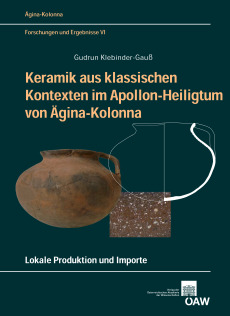Gudrun Klebinder-Gauß
Keramik aus klassischen Kontexten im Apollon-Heiligtum von Ägina-Kolonna
Lokale Produktion und Importe
Reihe herausgegeben von Manfred Bietak, Beiträge von Myrto Georgakopoulos, Reihe herausgegeben von Hermann Hunger, Beiträge von Evangelia Kiriatzi, Beiträge von Areti Pentedeka, Beiträge von Jörg Weilhartner
Reihe: Denkschrift der GesamtakademieDie Insel Ägina mit ihrem gleichnamigen Hauptort war in der spätarchaischen und klassischen Periode ein wichtiges Zentrum in der zentralen Ägäis. Die Bedeutung und der Wohlstand Äginas resultierten aus der intensiven Handelstätigkeit seiner Flotte mit weit reichenden Verbindungen über den Saronischen Golf hinaus bis in das Schwarzmeergebiet, nach Nordafrika und Italien. Der vorliegende Band untersucht Keramik aus klassischen Kontexten im Gebiet des „Kolonna-Hügels“, der Akropolis der antiken Inselhauptstadt. Diese Kontexte enthalten neben einer Reihe von Importen, darunter solche aus Attika, Korinth, Lakonien, Ostgriechenland und der nördlichen Ägäis, auch zahlreiche Gefässe lokaler Herkunft. Neben der stilistischen und chronologischen Auswertung der Keramik und der daraus abgeleiteten Interpretation der Kontexte liegt der Schwerpunkt dieses Bandes auf der bislang wenig erforschten lokalen Keramikproduktion. Unter Miteinbeziehung naturwissenschaftlicher Untersuchungen und antiker Schriftquellen wird das Bild eines bedeutenden Produktionszentrums von Kochkeramik gezeichnet, das ein breites Formenspektrum entwickelte und seine Erzeugnisse weithin exportierte. Über die Untersuchung von stilistischen Entwicklungen der Keramik dieser Epoche hinaus wird auch eine Verbindung zur historischen und wirtschaftlichen Situation Äginas in klassischer Zeit hergestellt und seine Rolle als bedeutende Handelsmacht und Rivale Athens beleuchtet.

